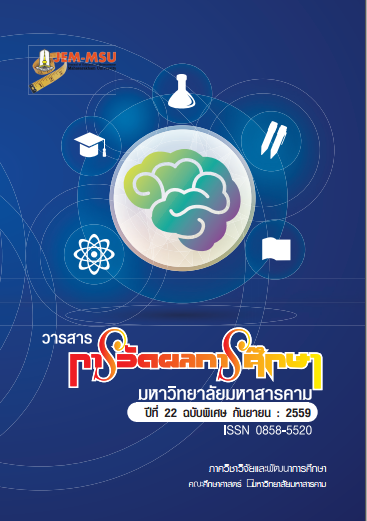A Comparison Pratomsuksa 5 Students’ Number Sense, Analysis Thinking, Attitude, and Mathematics Learning Achievement Through Learning CIPPA Activity Using Multimedia and Games
Main Article Content
Abstract
The purposes of this research were to compare Pratomsuksa 5 students’ number
sense, analysis thinking, attitude and mathematics learning achievement through learning
CIPPA Activity Using Multimedia and Games. The sample consisted of 66 students in
Pratomsuksa 5 of Nampong School, selected through the cluster random sampling technique.
The research instruments were ; 1) 7 lesson plans which Organized activity by Multimedia and 7
lesson plans which Organized by Game; 2) a 35-item Number sense test with difficulties from
.24 -.79, discriminating powers from .20 -.77 and a reliability of .80; 3) a 21-item achievement test
of mathematics with discriminating powers from .21-.51 and a reliability of .68; and 4) a 21-item
scale on Analysis Thinking with difficulties from .60-.79, discriminating powers from .27-.63
and a reliability of .75; 5) a 21-item Attitudes toward Learning Activities with discriminating
powers from .29 -.59 and a reliability of .69; The collected data were analyzed by mean,
standard deviation, Independent Sample t-test , F-test (one-way ANOVA), Hotelling’s T2:
Dependent and Post hoc test by Univariate t-test. Results of study were; 1) The achievement
score on number sense, analytical thinking and attitude after learning CIPPA activity using
multimedia as the instructional media was higher than that before learning at the 0.1 level
of significance. 2) The achievement score on number sense, analysis thinking and attitude
after learning learning CIPPA activity using games as the instructional media was higher than
that before studying at the 0.1 level of significance. 3) The results of the study revealed
that the achievement scores of the students who learned by the CIPPA activity using
multimedia as the instructional media and the students who learned by the CIPPA activity
using game as the instructional media were different at the .01 level of significance. The
achievement score on number sense and analytical thinking of the students who learned by
the CIPPA activity using game was higher than that of the students who learned by the
CIPPA activity using multimedia. As for the attitude toward learning, the students who
learned by the CIPPA activity using multimedia had point average of attitude toward learning
higher than that of the students who learned by the CIPPA activity using game.
Article Details
The content and information contained in the published article in the Journal of Educational Measurement Mahasarakham University represent the opinions and responsibilities of the authors directly. The editorial board of the journal is not necessarily in agreement with or responsible for any of the content.
The articles, data, content, images, etc. that have been published in the Journal of Educational Measurement Mahasarakham University are copyrighted by the journal. If any individual or organization wishes to reproduce or perform any actions involving the entirety or any part of the content, they must obtain written permission from the Journal of Educational Measurement Mahasarakham University.


